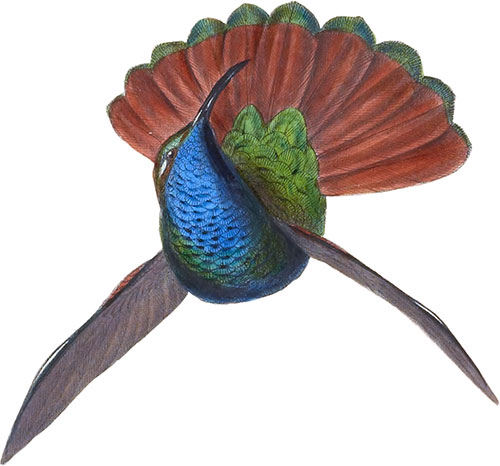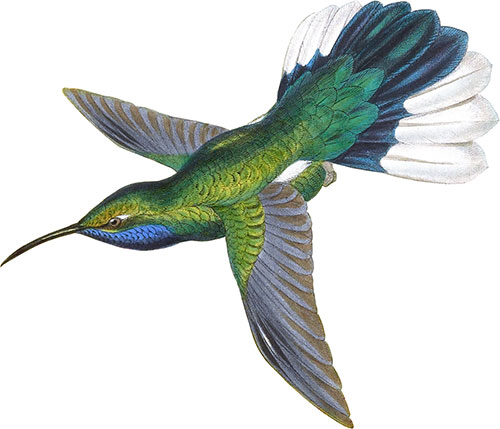Villavicencio’s Sabre-wing
The forests between the upper waters of the Napo and Quito.
The Campyopterus Villavicencio was first described by M. Bourcier, from a specimen obtained by him during his sojourn in Ecuador, and named in honour of a gentleman attached to the study of natural history resident in that country.
A single specimen is also contained in the Loddigesian collection. Both these examples appear to be females, and assimilate so closely in size and in some parts of their colouring to the bird lately named C. splendens by Mr. G. N. Lawrence of New York, that I am induced to believe them to be so many examples of one and the same species. I do net, however, insist upon such being the case, and therefore only place them together provisionally. In the length and form of the bill, in the general colouring of the tail and of the upper and under surface, they are precisely similar; the only observable difference being, that Mr. Lawrence’s specimen has a splendid deep-blue throat-mark, which is entirely absent in M. Bourcier’s and the Loddigesian examples. As both sexes of some other species of the Campylopteri are very sombrely coloured, it is just possible that Mr. Lawrence’s bird may prove to be distinct, in which case his name of splendens may be restored, and retained for the bird represented in the upper figure on the accompanying Plate, and that of Villavicencio for the lower one. Mr. Lawrence’s example was procured by Mr. Wm. E. Moore, between the head waters of the Napo and Quito, the same locality in which the other specimens were obtained.
The following is a description of M. Bourcier’s specimen:—
Crown of the head metallic golden green; upper surface, wing-coverts and flanks dark golden green; wings purplish brown; two centre tail-feathers dark green, the remainder steel-blue, the two outer ones tipped, and the others slightly fringed with greyish white at the tip; all the under surface ashy grey; bill black; feet brown.
Mr. Lawrence’s specimen differs in having a gorget of rich deep metallic blue on the throat, and in the lateral tail-feathers being merely fringed instead of tipped with greyish white.
The Plate represents the two birds of the natural size. The plant is the Gualtheria bracteata.
 Campyloterus lazulus
Lazuline Sabre-wing
Campyloterus lazulus
Lazuline Sabre-wing
 Campylopterus Delattrei
De Lattre’s Sabre-wing
Campylopterus Delattrei
De Lattre’s Sabre-wing
 Campylopterus ensipennis
Blue-throated Sabre-wing
Campylopterus ensipennis
Blue-throated Sabre-wing
 Campylopterus Villavicencio
Villavicencio’s Sabre-wing
Campylopterus Villavicencio
Villavicencio’s Sabre-wing
 Campylopterus latipennis
Broad-shafted Sabre-wing
Campylopterus latipennis
Broad-shafted Sabre-wing
 Campylopterus obscurus
Sombre Sabre-wing
Campylopterus obscurus
Sombre Sabre-wing
 Campylopterus rufus
Fawn-breasted Sabre-wing
Campylopterus rufus
Fawn-breasted Sabre-wing
 Campylopterus hyperythrus
Rufous-breasted Sabre-wing
Campylopterus hyperythrus
Rufous-breasted Sabre-wing
 Campylopterus phainopeplus
Simons’s Sabre-wing
Campylopterus phainopeplus
Simons’s Sabre-wing
Featuring all 422 illustrated species from John Gould’s A Monograph of the Trochilidæ, or Family of Humming-Birds arranged by color.